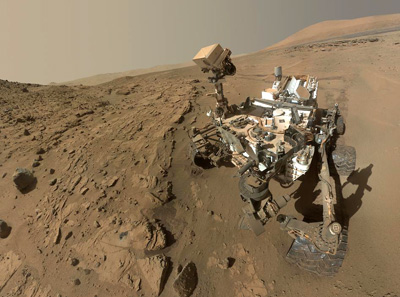
NASA has announced the selection of seven science instruments to be included on the Mars 2020 rover. Three scientists from the University of Hawaiʻi at Mānoa’s School of Ocean and Earth Science and Technology—Sarah Fagents, Shiv Sharma and Anupam Misra—will be members on the instrument teams to conduct unprecedented science and exploration technology investigations on the Red Planet.
The new rover will carry sophisticated hardware and instruments to perform geological assessments of the rover’s landing site, determine the potential habitability of the environment, and directly search for signs of ancient Martian life.
Among the instruments selected is the Mastcam-Z, an advanced camera system with panoramic and 3-D imaging capability with the ability to zoom. As the Mastcam-Z team’s volcanologist, Fagents, a researcher at UH Mānoa’s Hawaiʻi Institute of Geophysics and Planetology (HIGP), will identify and interpret rocks and terrains of volcanic origins that are encountered by the Mars 2020 rover. Further objectives of the Mastcam-Z investigation on the NASA Mars 2020 rover are to assess current atmospheric and astronomical conditions, events and surface-atmosphere interactions and processes; and to provide operational support and scientific context for rover navigation.
Her background in field investigations of volcanic deposits on Earth and past experience with the Galileo mission to the Jupiter system provide context for observations made by the new generation of Mars rover-geologists. In spite of this preparation, Fagents knows that she and the Mars 2020 teams are headed into uncharted territory. “Perhaps the greatest challenge will be reaching the Martian surface safely,” Fagents said. “However, the current Mars Science Laboratory rover Curiosity has amply demonstrated that a successful landing is an eminently attainable feat of engineering.”
The SuperCam instrument can provide imaging, chemical composition analysis and mineralogy, and can detect organic compounds from a distance on and in rocks, soils and sediment layers on Mars. On this instrument team, Researcher Sharma and Associate Researcher Anupam Misra, both experts in Raman spectroscopy and fluorescence at HIGP, will assist with detection of biomarkers—indicators that life has been or is present.
Raman spectroscopy is a technique that aims a laser beam at rocks or other material and, based on the specific wavelengths of light that are emitted back toward the instrument, uniquely identifies minerals and organic substances.
“This will be the culmination of over 15 years of work within HIGP developing the time-resolved active spectroscopic techniques for Mars rover from remote distances. We are thrilled to be the part of SuperCam Team,” said Sharma.
Read the HIGP story for more.
—By Marcie Grabowski

